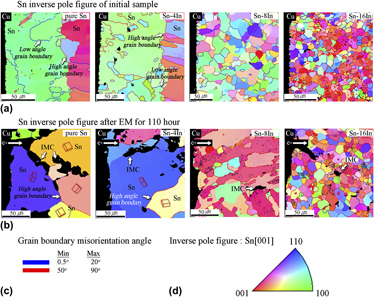Crossref Citations
This article has been cited by the following publications. This list is generated based on data provided by
Crossref.
Kim, Youngseok
Nagao, Shijo
Sugahara, Tohru
Suganuma, Katsuaki
Ueshima, Minoru
Albrecht, Hans-Juergen
Wilke, Klaus
and
Strogies, Joerg
2014.
Enhanced reliability of Sn–Ag–Bi–In joint under electric current stress by adding Co/Ni elements.
Journal of Materials Science: Materials in Electronics,
Vol. 25,
Issue. 7,
p.
3090.
Kim, Youngseok
Nagao, Shijo
Sugahara, Tohru
Suganuma, Katsuaki
Ueshima, Minoru
Albrecht, Hans-Juergen
Wilke, Klaus
and
Strogies, Joerg
2014.
Refinement of the Microstructure of Sn-Ag-Bi-In Solder, by Addition of SiC Nanoparticles, to Reduce Electromigration Damage Under High Electric Current.
Journal of Electronic Materials,
Vol. 43,
Issue. 12,
p.
4428.
Kim, Youngseok
Nagao, Shijo
Sugahara, Tohru
Suganuma, Katsuaki
Ueshima, Minoru
Albrecht, Hans-Juergen
Wilke, Klaus
and
Strogies, Joerg
2014.
Effect of electromigration on mechanical shock behavior in solder joints of surface mounted chip components.
Japanese Journal of Applied Physics,
Vol. 53,
Issue. 4S,
p.
04EB02.
Xie, H.X.
Friedman, D.
Mirpuri, K.
and
Chawla, N.
2014.
Electromigration Damage Characterization in Sn-3.9Ag-0.7Cu and Sn-3.9Ag-0.7Cu-0.5Ce Solder Joints by Three-Dimensional X-ray Tomography and Scanning Electron Microscopy.
Journal of Electronic Materials,
Vol. 43,
Issue. 1,
p.
33.
Huang, T.C.
Yang, T.L.
Ke, J.H.
Hsueh, C.H.
and
Kao, C.R.
2014.
Effects of Sn grain orientation on substrate dissolution and intermetallic precipitation in solder joints under electron current stressing.
Scripta Materialia,
Vol. 80,
Issue. ,
p.
37.
Bashir, M. Nasir
Haseeb, A.S.M.A.
Rahman, Abu Zayed Mohammad Saliqur
and
Fazal, M.A.
2016.
Effect of Cobalt Doping on the Microstructure and Tensile Properties of Lead Free Solder Joint Subjected to Electromigration.
Journal of Materials Science & Technology,
Vol. 32,
Issue. 11,
p.
1129.
Wang, Ting-Hui
and
Lin, Kwang-Lung
2016.
The Dissolution and Supersaturation of Zn in the Sn9Zn Solder Under Current Stressing.
Journal of Electronic Materials,
Vol. 45,
Issue. 1,
p.
164.
Shu, Yang
Gheybi Hashemabad, Somayeh
Ando, Teiichi
and
Gu, Zhiyong
2016.
Ultrasonic powder consolidation of Sn/In nanosolder particles and their application to low temperature Cu-Cu joining.
Materials & Design,
Vol. 111,
Issue. ,
p.
631.
Wu, Jie
Xue, Song-bai
Wang, Jing-wen
Liu, Shuang
Han, Yi-long
and
Wang, Liu-jue
2016.
Recent progress of Sn–Ag–Cu lead-free solders bearing alloy elements and nanoparticles in electronic packaging.
Journal of Materials Science: Materials in Electronics,
Vol. 27,
Issue. 12,
p.
12729.
Li, Zhiqiang
Xue, Songbai
and
Ding, Qingjun
2017.
Preparation and Performance Test of Soldered Stators of Ultrasonic Motor.
Journal of Testing and Evaluation,
Vol. 45,
Issue. 3,
p.
980.
Mao, Jie
Reeves, Benjamin
Lenz, Brendan
Ruscitto,
Daniel
and
Lewis, Dan
2017.
Study on the Effect of Mn, Zn, and Sb on Undercooling Behavior of Sn-Ag-Cu Alloys Using Differential Thermal Analysis.
Journal of Electronic Materials,
Vol. 46,
Issue. 11,
p.
6319.
Wang, Yan
Wang, Yishu
Han, Jing
Tan, Shihai
and
Guo, Fu
2018.
Effects of Sn grain c-axis on electromigration in Cu reinforced composite solder joints.
Journal of Materials Science: Materials in Electronics,
Vol. 29,
Issue. 7,
p.
5954.
KADOGUCHI, Takuya
2018.
Electromigration Phenomenon in Solder Joint.
JOURNAL OF THE JAPAN WELDING SOCIETY,
Vol. 87,
Issue. 7,
p.
503.
Guo, Qiang
Fu, Xidan
Guo, Xiaolei
Liu, Zhiying
Shi, Yan
and
Zhang, Di
2018.
Indentation-Enabled In Situ Mechanical Characterization of Micro/Nanopillars in Electron Microscopes.
JOM,
Vol. 70,
Issue. 4,
p.
487.
Baek, Sung-Min
Park, Yujin
Oh, Cheolmin
Chun, Eun-Joon
and
Kang, Namhyun
2019.
Modeling and Experimental Verification of Intermetallic Compounds Grown by Electromigration and Thermomigration for Sn-0.7Cu Solders.
Journal of Electronic Materials,
Vol. 48,
Issue. 1,
p.
142.
Yang, Li
Wang, Gangang
Xiong, Yifeng
Shen, Sai
and
Zhang, Yaocheng
2020.
Investigation of Cu particles size and bonding time on the microstructure and shear property of Cu/In-45Cu/Cu solder joints.
Materials Research Express,
Vol. 7,
Issue. 1,
p.
016314.
Zhang, Peng
Xue, Songbai
and
Wang, Jianhao
2020.
New challenges of miniaturization of electronic devices: Electromigration and thermomigration in lead-free solder joints.
Materials & Design,
Vol. 192,
Issue. ,
p.
108726.
Yamanaka, Kimihiro
Kondo, Naoki
and
Mizutori, Hiiro
2021.
Effect of Sb Addition on Electromigration in Solder Joints.
Journal of The Japan Institute of Electronics Packaging,
Vol. 24,
Issue. 6,
p.
606.
Shen, Yu-An
and
Wu, John A.
2022.
Effect of Sn Grain Orientation on Reliability Issues of Sn-Rich Solder Joints.
Materials,
Vol. 15,
Issue. 14,
p.
5086.
Hou, Zhuangzhuang
Zhao, Xiuchen
Wang, Yong
Gu, Yue
Tan, Chengwen
Xie, Xiaochen
Huo, Yongjun
and
Liu, Ying
2022.
Alloying regulation mechanism toward microstructure evolution of Sn-bi-based solder joint under current stress.
Materials Characterization,
Vol. 191,
Issue. ,
p.
112094.





